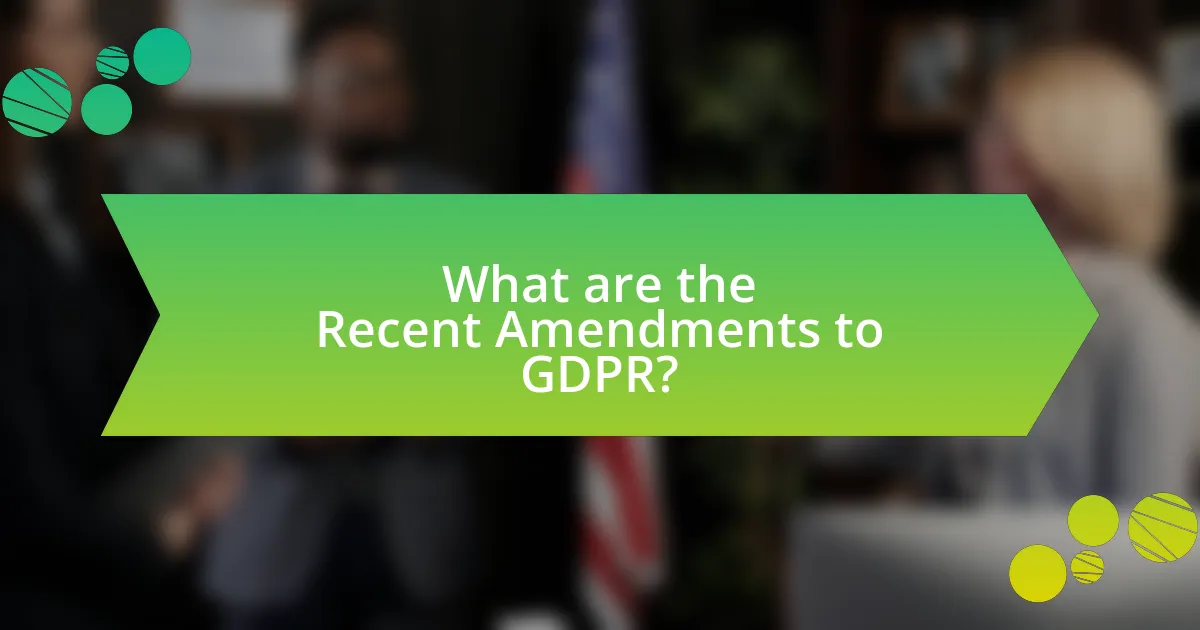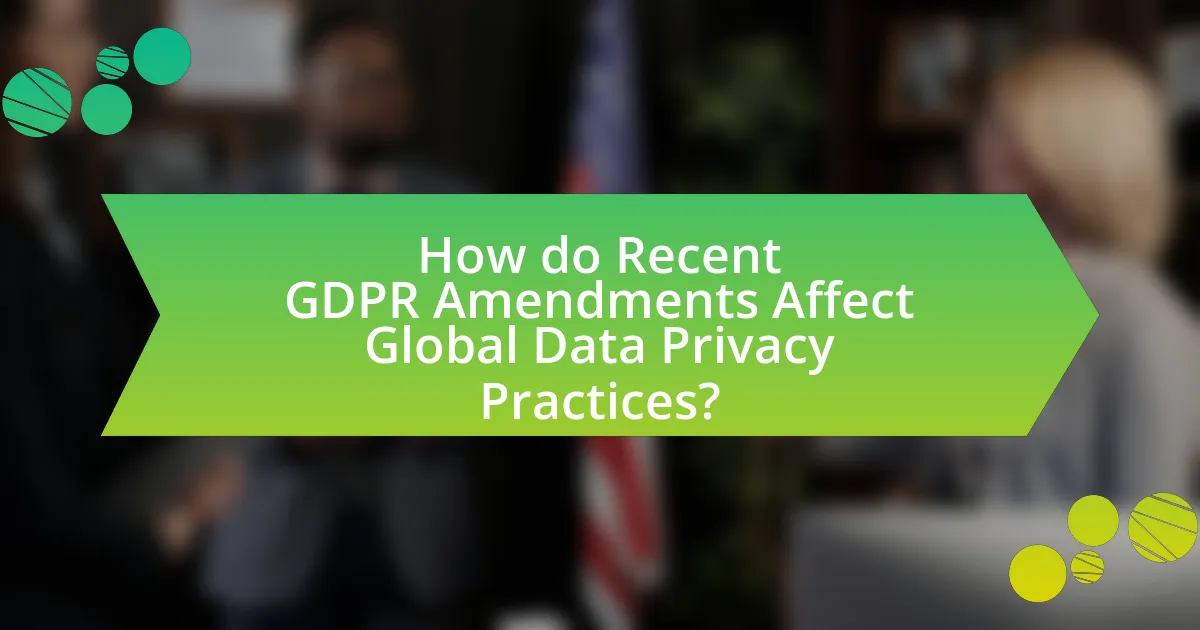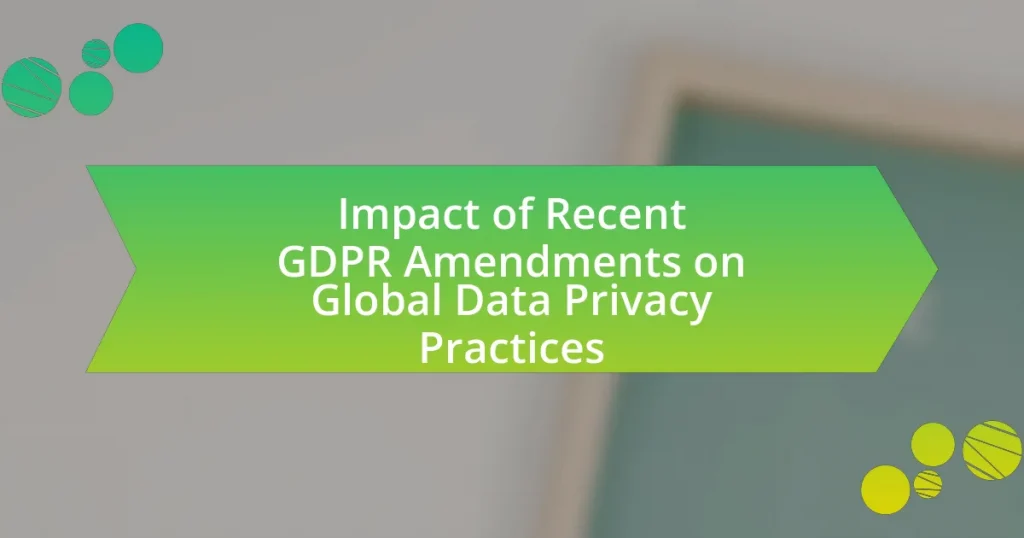The article focuses on the recent amendments to the General Data Protection Regulation (GDPR) and their significant impact on global data privacy practices. It outlines key updates aimed at enhancing data subject rights, clarifying compliance obligations for organizations, and addressing international data transfers. The amendments introduce stricter consent requirements, increased accountability for data processors, and heavier penalties for non-compliance, which can reach up to 4% of global annual turnover. Additionally, the article discusses the implications for businesses, the challenges of aligning with local laws, and best practices for maintaining compliance in a rapidly evolving data landscape.

What are the Recent Amendments to GDPR?
Recent amendments to the General Data Protection Regulation (GDPR) primarily include updates aimed at enhancing data subject rights and clarifying compliance obligations for organizations. Notably, the European Data Protection Board (EDPB) has emphasized the importance of transparency in data processing and the need for organizations to implement stronger data protection measures. These amendments also address the growing concerns around data transfers outside the European Union, reinforcing the necessity for adequate safeguards. The amendments reflect ongoing efforts to adapt to technological advancements and evolving privacy challenges, ensuring that data protection remains robust and effective in a digital landscape.
How do these amendments differ from previous GDPR regulations?
The recent amendments to GDPR regulations introduce stricter compliance requirements and enhanced rights for individuals compared to previous versions. These amendments emphasize greater accountability for data processors, mandate clearer consent mechanisms, and expand the scope of data subject rights, such as the right to data portability and the right to erasure. For instance, the amendments require organizations to implement data protection by design and by default, which was less emphasized in earlier regulations. Additionally, the amendments impose heavier fines for non-compliance, with penalties reaching up to 4% of global annual turnover, reinforcing the importance of adherence to data protection standards.
What specific changes have been implemented in the recent amendments?
The recent amendments to the GDPR have implemented stricter consent requirements for data processing, enhancing user control over personal data. These changes include the necessity for explicit consent for data collection, clearer information on data usage, and the introduction of stronger penalties for non-compliance, which can reach up to 4% of a company’s global revenue. Additionally, the amendments emphasize the importance of data protection by design and by default, mandating that organizations integrate data protection measures into their processing activities from the outset.
Why were these amendments necessary in the current data landscape?
The amendments were necessary in the current data landscape to enhance consumer protection and address evolving technological challenges. As data breaches and privacy violations have increased, the amendments aim to strengthen individuals’ rights over their personal data, ensuring greater transparency and accountability from organizations. For instance, the introduction of stricter consent requirements and clearer data processing guidelines reflects the need to adapt to the complexities of digital ecosystems, where data is often shared across multiple platforms. These changes are crucial in maintaining public trust and aligning with global data protection standards, as evidenced by the rising number of data protection regulations worldwide, such as the California Consumer Privacy Act (CCPA) and Brazil’s General Data Protection Law (LGPD).
What are the implications of these amendments for businesses?
The implications of these amendments for businesses include increased compliance costs and heightened accountability regarding data protection. Businesses must invest in updated data management systems and training to align with the new requirements, which can strain financial resources. Additionally, non-compliance risks have escalated, with potential fines reaching up to 4% of annual global turnover, as established by the GDPR framework. This necessitates a proactive approach to data governance, compelling businesses to adopt more rigorous privacy policies and practices to mitigate legal risks and maintain consumer trust.
How will businesses need to adjust their data handling practices?
Businesses will need to adjust their data handling practices by implementing stricter compliance measures to align with the recent GDPR amendments. These amendments emphasize enhanced transparency, requiring businesses to provide clearer information on data processing activities and obtain explicit consent from users. For instance, organizations must ensure that data subjects can easily access their data and understand how it is being used, which is supported by the GDPR’s focus on user rights. Additionally, businesses will need to adopt robust data protection strategies, including regular audits and impact assessments, to mitigate risks associated with data breaches, as non-compliance can lead to significant fines, with penalties reaching up to 4% of annual global turnover or €20 million, whichever is higher.
What penalties could businesses face for non-compliance with the amendments?
Businesses could face significant fines for non-compliance with the amendments to the GDPR, with penalties reaching up to 4% of their annual global turnover or €20 million, whichever is higher. This strict enforcement is designed to ensure adherence to data protection regulations, reflecting the EU’s commitment to safeguarding personal data. The severity of these penalties underscores the importance of compliance, as non-compliance can also lead to reputational damage and loss of consumer trust, further impacting a business’s financial standing.

How do Recent GDPR Amendments Affect Global Data Privacy Practices?
Recent amendments to the General Data Protection Regulation (GDPR) significantly influence global data privacy practices by establishing stricter compliance requirements and enhancing individual rights. These amendments, which include provisions for increased transparency and accountability, compel organizations worldwide to adopt more rigorous data protection measures. For instance, the introduction of higher fines for non-compliance, which can reach up to 4% of global annual turnover, incentivizes companies to prioritize data privacy. Additionally, the amendments emphasize the importance of data subject rights, such as the right to access and the right to erasure, prompting businesses globally to implement processes that align with these rights. As a result, organizations outside the EU are increasingly adopting GDPR-like frameworks to ensure compliance and maintain consumer trust, reflecting a broader shift towards enhanced data privacy standards on a global scale.
What impact do these amendments have on international data transfers?
The amendments to the GDPR significantly restrict international data transfers by imposing stricter conditions for transferring personal data outside the European Economic Area (EEA). These changes require organizations to ensure that the receiving country provides an adequate level of data protection, as determined by the European Commission, or to implement additional safeguards, such as Standard Contractual Clauses (SCCs) or Binding Corporate Rules (BCRs). For instance, the invalidation of the Privacy Shield framework in 2020 highlighted the need for enhanced scrutiny of U.S. data protection practices, leading to increased compliance costs and operational challenges for companies engaged in transatlantic data flows.
How do the amendments align with data privacy laws in other countries?
The amendments align with data privacy laws in other countries by enhancing protections similar to those found in frameworks like the General Data Protection Regulation (GDPR) in the European Union and the California Consumer Privacy Act (CCPA) in the United States. These amendments introduce stricter consent requirements, data subject rights, and accountability measures that mirror the principles established in these international laws. For instance, the GDPR emphasizes user consent and the right to access personal data, which is reflected in the recent amendments that require organizations to obtain explicit consent before processing personal information. Additionally, the amendments promote transparency and data minimization, aligning with the CCPA’s focus on consumer rights and data protection. This alignment indicates a global trend towards more robust data privacy standards, fostering international cooperation and compliance among businesses operating across borders.
What challenges do businesses face in complying with both GDPR and local laws?
Businesses face significant challenges in complying with both GDPR and local laws due to the complexity and potential conflicts between regulations. The GDPR establishes strict data protection standards that may not align with local laws, leading to confusion and increased compliance costs. For instance, while GDPR mandates explicit consent for data processing, some local laws may allow for broader interpretations of consent, creating discrepancies in compliance requirements. Additionally, businesses operating in multiple jurisdictions must navigate varying enforcement mechanisms and penalties, which complicates their compliance strategies. This dual compliance burden can strain resources and necessitate specialized legal expertise to ensure adherence to both sets of regulations.
How are global companies responding to these changes?
Global companies are enhancing their data privacy practices in response to recent GDPR amendments. Many organizations are investing in advanced compliance technologies and revising their data handling policies to align with stricter regulations. For instance, companies like Microsoft and Google have implemented more robust data encryption and user consent mechanisms to ensure compliance. Additionally, firms are increasing transparency by providing clearer privacy notices and allowing users greater control over their personal data. This shift is evidenced by a 2022 survey indicating that 70% of companies have updated their privacy policies to reflect GDPR changes, demonstrating a proactive approach to data protection.
What strategies are companies adopting to ensure compliance?
Companies are adopting several strategies to ensure compliance with GDPR amendments, including implementing robust data governance frameworks, conducting regular audits, and providing employee training on data protection. These strategies help organizations systematically manage data privacy risks and align their practices with regulatory requirements. For instance, a survey by the International Association of Privacy Professionals (IAPP) found that 79% of organizations have increased their investment in data protection technologies since the introduction of GDPR, demonstrating a proactive approach to compliance. Additionally, many companies are appointing Data Protection Officers (DPOs) to oversee compliance efforts, ensuring accountability and adherence to legal standards.
How are companies communicating these changes to their customers?
Companies are communicating changes related to GDPR amendments to their customers primarily through direct email notifications, updated privacy policies on their websites, and public announcements via social media platforms. For instance, many organizations have sent detailed emails outlining how their data handling practices have evolved in response to the amendments, ensuring transparency and compliance. Additionally, companies are revising their privacy policies to reflect the new regulations, making these documents easily accessible on their websites. This approach not only informs customers but also builds trust by demonstrating a commitment to data protection and privacy.

What Best Practices Should Organizations Follow Post-Amendments?
Organizations should implement comprehensive data protection assessments and update their privacy policies to align with the recent GDPR amendments. Conducting regular audits ensures compliance with the new regulations, while revising privacy policies communicates changes transparently to stakeholders. Additionally, organizations should enhance employee training on data privacy practices, as informed staff are crucial for maintaining compliance. Establishing clear data processing agreements with third-party vendors is also essential, as it mitigates risks associated with data sharing. These practices are supported by the European Data Protection Board’s guidelines, which emphasize accountability and transparency in data handling.
How can organizations effectively implement the new GDPR requirements?
Organizations can effectively implement the new GDPR requirements by conducting a comprehensive data audit to identify and classify personal data, ensuring compliance with data protection principles. This involves mapping data flows, assessing data processing activities, and determining the legal basis for processing personal data. Additionally, organizations should establish clear data protection policies, provide training for employees on GDPR compliance, and implement technical and organizational measures to safeguard personal data. Regularly reviewing and updating these practices in response to regulatory changes and conducting impact assessments for high-risk processing activities further strengthens compliance efforts.
What tools and resources are available to assist with compliance?
Various tools and resources are available to assist with compliance, particularly in the context of GDPR amendments. Compliance management software, such as OneTrust and TrustArc, provides frameworks for organizations to assess and manage their data privacy practices effectively. Additionally, legal resources like the GDPR text itself and guidance from regulatory bodies, such as the European Data Protection Board, offer essential information on compliance requirements. Training programs and certifications, such as those offered by the International Association of Privacy Professionals (IAPP), equip professionals with the knowledge needed to navigate compliance challenges. These resources collectively support organizations in aligning their practices with GDPR standards and ensuring ongoing compliance.
What training should be provided to employees regarding data privacy?
Employees should receive training on data privacy that covers the principles of the General Data Protection Regulation (GDPR), including data protection rights, data handling procedures, and the importance of consent. This training should also include practical scenarios to help employees understand how to identify and respond to data breaches, as well as the consequences of non-compliance, which can include significant fines and reputational damage. According to the European Commission, organizations that implement comprehensive data protection training can reduce the risk of data breaches by up to 30%.
What common pitfalls should organizations avoid in light of the amendments?
Organizations should avoid the pitfalls of non-compliance, inadequate training, and insufficient data protection measures in light of the amendments. Non-compliance can lead to significant fines, as seen in cases where organizations failed to adhere to GDPR regulations, resulting in penalties reaching millions of euros. Inadequate training of employees on data privacy practices can lead to unintentional breaches, as employees may not be aware of the updated requirements. Insufficient data protection measures, such as failing to implement robust encryption or access controls, can expose sensitive information to unauthorized access, increasing the risk of data breaches. These pitfalls can severely undermine an organization’s reputation and operational integrity.
How can organizations ensure they are not overlooking critical compliance areas?
Organizations can ensure they are not overlooking critical compliance areas by implementing a comprehensive compliance framework that includes regular audits, employee training, and staying updated on regulatory changes. Regular audits help identify gaps in compliance, while employee training ensures that all staff are aware of their responsibilities under regulations like GDPR. Additionally, subscribing to legal updates and engaging with compliance experts can provide organizations with timely information on amendments and best practices, thereby reinforcing their compliance efforts.
What steps can organizations take to maintain ongoing compliance?
Organizations can maintain ongoing compliance by implementing a robust compliance management system that includes regular audits, employee training, and updated policies. Regular audits help identify gaps in compliance with GDPR amendments, ensuring that organizations can address issues proactively. Employee training is essential to keep staff informed about data privacy practices and legal obligations, which fosters a culture of compliance. Additionally, organizations should continuously update their data protection policies to reflect changes in regulations and best practices, ensuring alignment with the latest GDPR requirements. This approach is supported by the European Data Protection Board’s guidelines, which emphasize the importance of accountability and proactive compliance measures in data protection.






